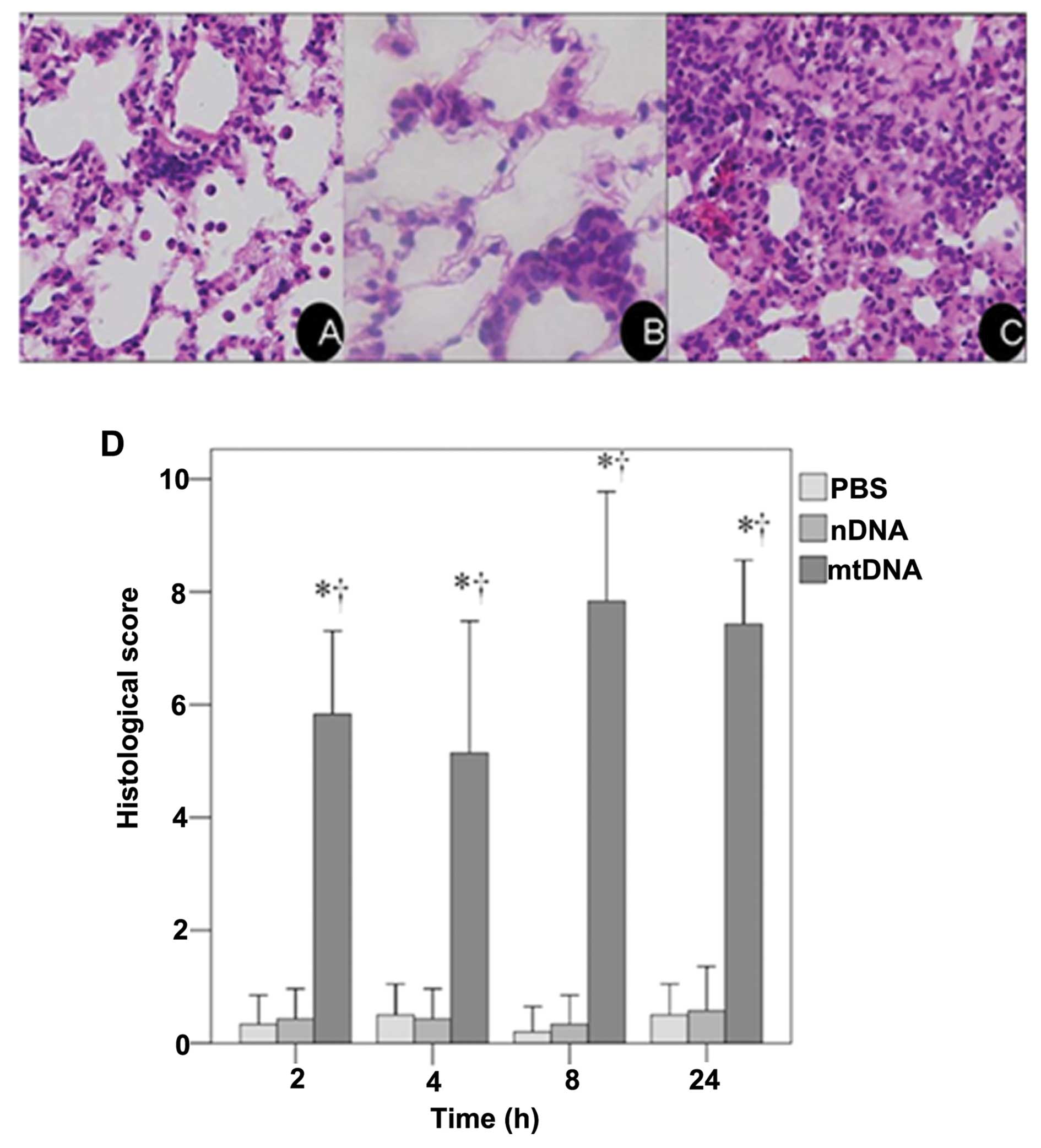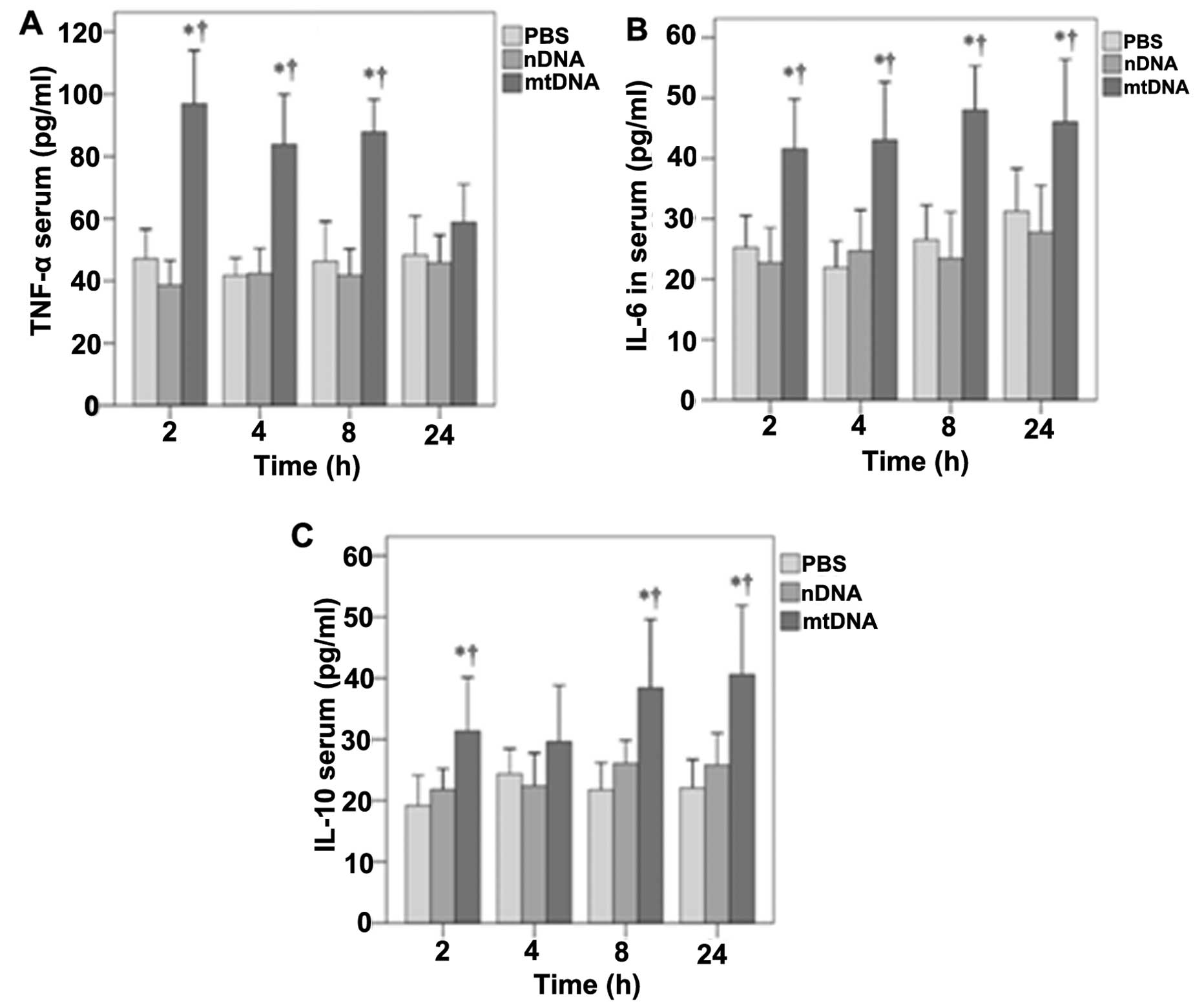|
1
|
Tsukamoto T, Chanthaphavong RS and Pape
HC: Current theories on the pathophysiology of multiple organ
failure after trauma. Injury. 41:21–26. 2010. View Article : Google Scholar : PubMed/NCBI
|
|
2
|
Kitajima I and Niimi H: Establishment of
the rapid, hypersensitive testing systems for sepsis/SIRS. Rinsho
Byori. 60:46–51. 2012.(In Japanese).
|
|
3
|
Pittet D, Rangel-Frausto S, Li N, et al:
Systemic inflammatory response syndrome, sepsis, severe sepsis and
septic shock: incidence, morbidities and outcomes in surgical ICU
patients. Intensive Care Med. 21:302–309. 1995. View Article : Google Scholar : PubMed/NCBI
|
|
4
|
Tarlowe MH, Kannan KB, Itagaki K, Adams
JM, Livingston DH and Hauser CJ: Inflammatory chemoreceptor
cross-talk suppresses leukotriene B4 receptor 1-mediated neutrophil
calcium mobilization and chemotaxis after trauma. J Immunol.
171:2066–2073. 2003. View Article : Google Scholar : PubMed/NCBI
|
|
5
|
Bone LB and Giannoudis P: Femoral shaft
fracture fixation and chest injury after polytrauma. J Bone Joint
Surg Am. 93:311–317. 2011. View Article : Google Scholar : PubMed/NCBI
|
|
6
|
Pugin J: How tissue injury alarms the
immune system and causes a systemic inflammatory response syndrome.
Ann Intensive Care. 2:272012. View Article : Google Scholar : PubMed/NCBI
|
|
7
|
MacKenzie EJ: Epidemiology of injuries:
current trends and future challenges. Epidemiol Rev. 22:112–119.
2000. View Article : Google Scholar : PubMed/NCBI
|
|
8
|
Aller MA, Arias JI, Alonso-Poza A and
Arias J: A review of metabolic staging in severely injured
patients. Scand J Trauma Resusc Emerg Med. 18:272010. View Article : Google Scholar : PubMed/NCBI
|
|
9
|
Hauser CJ, Sursal T, Rodriguez EK,
Appleton PT, Zhang Q and Itagaki K: Mitochondrial damage associated
molecular patterns from femoral reamings activate neutrophils
through formyl peptide receptors and P44/42 MAP kinase. J Orthop
Trauma. 24:534–538. 2010. View Article : Google Scholar
|
|
10
|
Zhang Q, Itagaki K and Hauser CJ:
Mitochondrial DNA is released by shock ; and activates neutrophils
via p38 map kinase. Shock. 34:55–59. 2010. View Article : Google Scholar : PubMed/NCBI
|
|
11
|
Zhang Q, Raoof M, Chen Y, et al:
Circulating mitochondrial DAMPs cause inflammatory responses to
injury. Nature. 464:104–107. 2010. View Article : Google Scholar : PubMed/NCBI
|
|
12
|
Kaczorowski DJ, Mollen KP, Edmonds R and
Billiar TR: Early events in the recognition of danger signals after
tissue injury. J Leukoc Biol. 83:546–552. 2008. View Article : Google Scholar : PubMed/NCBI
|
|
13
|
Klune JR and Tsung A: Molecular biology of
liver ischemia/reperfusion injury: established mechanisms and
recent advancements. Surg Clin North Am. 90:665–677. 2010.
View Article : Google Scholar : PubMed/NCBI
|
|
14
|
Kapetanovic R and Cavaillon JM: Early
events in innate immunity in the recognition of microbial
pathogens. Expert Opin Biol Ther. 7:907–918. 2007. View Article : Google Scholar : PubMed/NCBI
|
|
15
|
Dewar D, Moore FA, Moore EE and Balogh Z:
Postinjury multiple organ failure. Injury. 40:912–918. 2009.
View Article : Google Scholar : PubMed/NCBI
|
|
16
|
Pfeifer R, Tarkin IS, Rocos B and Pape HC:
Patterns of mortality and causes of death in polytrauma patients -
has anything changed? Injury. 40:907–911. 2009. View Article : Google Scholar : PubMed/NCBI
|
|
17
|
Rodriguez-Gaspar M, Santolaria F,
Jarque-Lopez A, et al: Prognostic value of cytokines in SIRS
general medical patients. Cytokine. 15:232–236. 2001. View Article : Google Scholar : PubMed/NCBI
|
|
18
|
Jaffer U, Wade RG and Gourlay T: Cytokines
in the systemic inflammatory response syndrome: a review. HSR Proc
Intensive Care Cardiovasc Anesth. 2:161–175. 2010.PubMed/NCBI
|
|
19
|
Goerdt S and Orfanos CE: Other functions,
other genes: alternative activation of antigen-presenting cells.
Immunity. 10:137–142. 1999. View Article : Google Scholar : PubMed/NCBI
|
|
20
|
Maggi LB Jr, Moran JM, Scarim AL, Ford DA,
Yoon JW, McHowat J, Buller RM and Corbett JA: Novel role for
calcium-independent phospholipase A(2) in the macrophage antiviral
response of inducible nitric-oxide synthase expression. J Biol
Chem. 277:38449–38455. 2002. View Article : Google Scholar : PubMed/NCBI
|
|
21
|
Mantovani A, Sozzani S, Locati M, Allavena
P and Sica A: Macrophage polarization: tumor-associated macrophages
as a paradigm for polarized M2 mononuclear phagocytes. Trends
Immunol. 23:549–555. 2002. View Article : Google Scholar : PubMed/NCBI
|
|
22
|
Sester DP, Stacey KJ, Sweet MJ, Beasley
SJ, Cronau SL and Hume DA: The actions of bacterial DNA on murine
macrophages. J Leukoc Biol. 66:542–548. 1999.PubMed/NCBI
|
|
23
|
Bhatia M, Zemans RL and Jeyaseelan S: Role
of chemokines in the pathogenesis of acute lung injury. Am J Respir
Cell Mol Biol. 46:566–572. 2012. View Article : Google Scholar : PubMed/NCBI
|
|
24
|
Christman JW, Lancaster LH and Blackwell
TS: Nuclear factor kappa B: a pivotal role in the systemic
inflammatory response syndrome and new target for therapy.
Intensive Care Med. 24:1131–1138. 1998. View Article : Google Scholar : PubMed/NCBI
|
|
25
|
Tak PP and Firestein GS: NF-kappaB: a key
role in inflammatory diseases. J Clin Invest. 107:7–11. 2001.
View Article : Google Scholar : PubMed/NCBI
|
|
26
|
Fukudome EY and Alam HB: Hypothermia in
multisystem trauma. Crit Care Med. 37:S265–S272. 2009. View Article : Google Scholar : PubMed/NCBI
|
|
27
|
Rowe C, Jenkins RE, Kitteringham NR, Park
KB and Goldring C: Analysis of the rat primary hepatocyte nuclear
proteome through sub-cellular fractionation. J Integrated OMICS.
2:94–105. 2012.
|
|
28
|
Sun T, Wang X, Liu Z, Liu S and Zhang J:
Patterns of cytokine release and evolution of remote organs from
proximal femur fracture in COPD rats. Injury. 42:825–832. 2011.
View Article : Google Scholar : PubMed/NCBI
|
|
29
|
Gray KD, Simovic MO, Chapman WC, et al:
Systemic nf-kappaB activation in a transgenic mouse model of acute
pancreatitis. J Surg Res. 110:310–314. 2003. View Article : Google Scholar : PubMed/NCBI
|
|
30
|
Deitch EA, Xu D and Kaise VL: Role of the
gut in the development of injury- and shock induced SIRS and MODS:
the gut-lymph hypothesis, a review. Front Biosci. 11:520–528. 2006.
View Article : Google Scholar : PubMed/NCBI
|
|
31
|
Li B, Zhang R, Li J, et al: Antimalarial
artesunate protects sepsis model mice against heat-killed
Escherichia coli challenge by decreasing TLR4, TLR9 mRNA
expressions and transcription factor NF-kappa B activation. Int
Immunopharmacol. 8:379–389. 2008. View Article : Google Scholar
|
|
32
|
Xiang M and Fan J: Pattern recognition
receptor-dependent mechanisms of acute lung injury. Mol Med.
16:69–82. 2010. View Article : Google Scholar : PubMed/NCBI
|
|
33
|
Hong Z, Jiang Z, Liangxi W, et al:
Chloroquine protects mice from challenge with CpG ODN and LPS by
decreasing proinflammatory cytokine release. Int Immunopharmacol.
4:223–234. 2004. View Article : Google Scholar : PubMed/NCBI
|
|
34
|
Hauser CJ: Preclinical models of
traumatic, hemorrhagic shock. Shock. 24(Suppl 1): S24–S32. 2005.
View Article : Google Scholar
|
|
35
|
Bianchi ME: DAMPs, PAMPs and alarmins: all
we need to know about danger. J Leukoc Biol. 81:1–5. 2007.
View Article : Google Scholar : PubMed/NCBI
|
|
36
|
Lenz A, Franklin GA and Cheadle WG:
Systemic inflammation after trauma. Injury. 38:1336–1345. 2007.
View Article : Google Scholar
|
|
37
|
Paquette IM and Burchard KW:
Hypoadrenalism following trauma: is sepsis always necessary? Int J
Clin Exp Med. 1:327–331. 2008.PubMed/NCBI
|
|
38
|
Raoof M, Zhang Q, Itagaki K and Hauser CJ:
Mitochondrial peptides are potent immune activators that activate
human neutrophils via FPR-1. J Trauma. 68:1328–1334. 2010.
View Article : Google Scholar : PubMed/NCBI
|
|
39
|
Benne R and Sloof P: Evolution of the
mitochondrial protein synthetic machinery. Biosystems. 21:51–68.
1987. View Article : Google Scholar : PubMed/NCBI
|
|
40
|
Chaung WW, Wu R, Ji Y, Dong W and Wang P:
Mitochondrial transcription factor A is a proinflammatory mediator
in hemorrhagic shock. Int J Mol Med. 30:199–203. 2012.PubMed/NCBI
|
|
41
|
Gogos CA, Drosou E, Bassaris HP and
Skoutelis A: Pro-versus anti-inflammatory cytokine profile in
patients with severe sepsis: a marker for prognosis and future
therapeutic options. J Infect Dis. 181:176–180. 2000. View Article : Google Scholar : PubMed/NCBI
|
|
42
|
Adib-Conquy M and Cavaillon JM: Host
inflammatory and anti-inflammatory response during sepsis. Pathol
Biol (Paris). 60:306–313. 2012.(In French).
|
|
43
|
Matsuda N, Hattori Y, Jesmin S and Gando
S: Nuclear factor-kappaB decoy oligodeoxynucleotides prevent acute
lung injury in mice with cecal ligation and puncture-induced
sepsis. Mol Pharmacol. 67:1018–1025. 2005. View Article : Google Scholar : PubMed/NCBI
|
|
44
|
Williams DL, Ha T, Li C, Laffan J,
Kalbfleisch J and Browder W: Inhibition of LPS-induced NFkappaB
activation by a glucan ligand involves down-regulation of IKKbeta
kinase activity and altered phosphorylation and degradation of
IkappaBalpha. Shock. 13:446–452. 2000. View Article : Google Scholar : PubMed/NCBI
|
|
45
|
Tschaikowsky K, Sittl R, Braun GG, Hering
W and Rügheimer E: Increased fMet-Leu-Phe receptor expression and
altered superoxide production of neutrophil granulocytes in septic
and posttraumatic patients. Clin Investig. 72:18–25. 1993.
|
|
46
|
Sugishita Y, Shimizu T, Yao A, et al:
Lipopolysaccharide augments expression and secretion of vascular
endothelial growth factor in rat ventricular myocytes. Biochem
Biophys Res Commun. 268:657–662. 2000. View Article : Google Scholar : PubMed/NCBI
|
|
47
|
Yi AK, Yoon H, Park JE, Kim BS, Kim HJ and
Martinez-Hernandez A: CpG DNA-mediated induction of acute liver
injury in D-galactosamine-sensitized mice: the mitochondrial
apoptotic pathway-dependent death of hepatocytes. J Biol Chem.
281:15001–15012. 2006. View Article : Google Scholar : PubMed/NCBI
|
|
48
|
Sun S, Sursal T, Adibnia Y, et al:
Mitochondrial DAMPs increase endothelial permeability through
neutrophil dependent and independent pathways. PLoS One.
8:e599892013. View Article : Google Scholar : PubMed/NCBI
|















